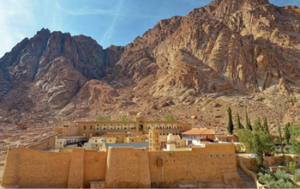Discover more about Egypt
At the crossroads of history, culture & civilizations
Take in the amazing centuries-old architecture of old Cairo and its synagogues, churches, and mosques. Stroll through the colorful streets of Khan-al Khalili, the most famous bazaar in Cairo full of spices, perfumes, jewelry, and souvenirs. Or visit the mysterious chambers of the Great Pyramid and discover the myths of the ancient Pharaos still living on a thousand years later.
We invite you to sail down the Nile river to discover the most ancient and oldest Egyptian sites in enchanting Luxor, the City of the Hundred Gates. Relax and unwind in the friendly town of Aswan, home to the Nubians, whose unique culture and history are as old as Egypt itself. Venture a bit further south and you’ll discover the Temple of Abu Simbel, Egypt’s most remarkable archaeological site, built by King Ramses II into a solid rock cliff.
Adventure into the desert by day and camp in style in luxurious tents by night, while stargazing at the beautiful open sky. Don’t forget to relax on the golden and white sand beaches of the Red Sea, home to the most beautiful coral reefs, marine life, and the place to be for diving and snorkeling.
Cairo
Cairo, the capital of Egypt, is one of the largest and most dynamic cities in the world with the Nile River splitting it into the east and west bank. A busy city that’s awake 24/7 with all sorts of entertaining attractions and monuments that go back to Pharaonic, Coptic, Islamic, and modern eras. And we can’t forget about the dazzling nightlife with luxurious cafes, restaurants, and nightclubs.
The Pyramids
Saqqara and Giza pyramid complex
The First Dynasty of ancient Egypt can be situated between the 34th and 30th century BC. Throughout the years the Egyptians built numerous pyramids, but just a few survived the age of time. One of the oldest complete stone-built pyramids is the Step Pyramid of Djoser at Saqqara, built in the Third Dynasty. If you have time, you should not miss Saqqara Necropolis housing early architecture Pyramids, Mastabas and the Imhotep Museum.
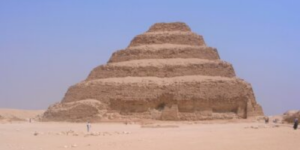

All the pyramids at the Giza Plateau were built during the Fourth Dynasty. The complex houses several small pyramids as well as the Great Sphinx and three main Pyramids: the Pyramid of Khafre, the Pyramid of Menkaure and the Great Pyramid of Khufu (Cheops). The latter also known as the Great Pyramid of Giza is the oldest of the Seven Wonders of the Ancient World that remained largely intact. With its hidden chambers, narrow passages, dangerous shafts, and mysterious energy, the Great Pyramid of Giza has yet to reveal all its secrets. Note that the pyramids in the complex were all meticulously built and aligned to the sun, the moon and the stars.
Old Cairo
Home to Jewish, Coptic, and Islamic architecture
The area of old Cairo is considered a mosaic of religions. Walking through the old medieval city streets and isles, you will notice several synagogues, churches, and mosques right next to each other. The Ben Ezra Synagogue is the oldest Jewish temple in town and regarded as the place where baby Moses’ basket was found by the Pharoah’s wife. Jewish historical documents buried under the synagogue’s floors gave it even more significance. Built on the southern gate of the Roman Fortress, The Hanging Church is known as the place where several apparitions of Mary and miracles took place. The Church, which is also known as the Cave Church —and said to be the place where Virgin Mary and baby Jesus hid for months— is part of the Coptic Orthodox Church of Alexandria and is officially called the Church of the Virgin Mary.
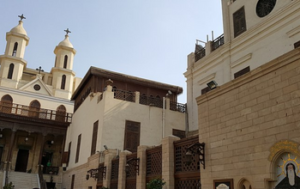
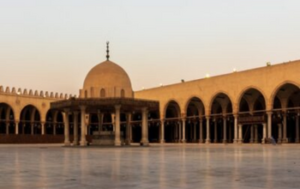
A few steps away lies the Amr Ibn Al-As Mosque, which is considered the first mosque ever built in Egypt —and even the whole of Africa— during the 7th century. It also served as a center of Islamic learning until it was replaced by Al-Azhar Mosque. Located nearby the Ibn Tulun Mosque is one of the oldest mosques in Egypt still standing in its original form. It was built in the ancient Egyptian architecture style and features a big courtyard allowing sunlight to accentuate the shadows on the walls and its famous minaret.
A couple of streets up is the massive Sultan Hassan Mosque, considered one of the largest mosques in the Islamic world with its tallest minaret measuring 68 meters. It was originally built as a place of worship and school (madrassa), but today it is frequently visited by tourists and locals. Opposite the mosque of Sultan Hassan, you can find Al-Rifai Mosque, another monumental building that serves as the site for annual Sufi celebrations commemorating imam Ahmad al‑Rifai. The mosque is home to the domes and mausoleums of the Turkish royal family, including the tomb of King Farouk, the last king of Egypt before it became a republic. Further north, you will find the Al-Azhar Mosque and University, which is renowned as the most prestigious and foremost institution in the Islamic world. It is a unique university offering Islamic theology as well as medical and engineering studies.
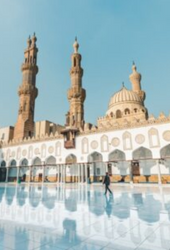
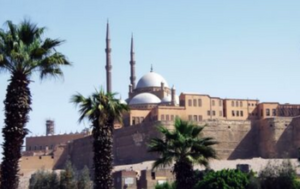
The Citadel of Saladin is undoubtedly the highlight of medieval Cairo, dominating the skyline from afar. It is a fortress built on the mountain of Al Moqattam by Salah ad-Din and further expanded by later subsequent rulers. From the 13th to the 19th century it was the residence of every ruler of Egypt, the cabinet, and the army. The citadel houses several mosques and museums. The Great Mosque of Mohamed Ali Pasha —also known as the Alabaster Mosque— was built by Mohamed Ali, the founder of modern Egypt, in 1830. It has gilded walls inside while its exterior is decorated with alabaster and bronze windows adorned with Islamic designs. The roof is formed of 46 domes.
The historic center of Cairo is also known for its old market area, Khan el Khalili, built in the 10th century. Originally it was established as a caravanserai, but it later served as a point of international trade of exotic spices, handmade jewelry, fabrics, clothes, and carpets. Today it is home to many artisans and local merchants along with traditional coffeehouses, restaurants, and street food vendors.
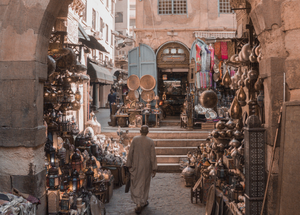
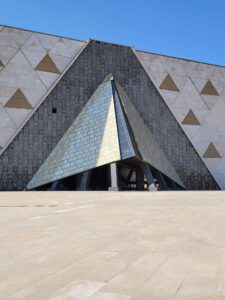
A visit to Cairo is not complete without stopping by The Museum of Egyptian Antiquities —commonly known as the Egyptian Museum— located just a few minutes away from Khan el Khaili in Tahrir Square. The museum houses an extensive collection of ancient Egyptian antiquities and artifacts. A must-see is the famous gold mask of King Tutankhamun, made of 11 kilograms of solid gold. Although the museum is still open to the public, many antiquities have already been moved to the new Grand Egyptian Museum (GEM) in Giza —next door to the Pyramids— scheduled to open in late 2023. It will be the world’s biggest museum dedicated to one single civilization. The architecture of the new museum will be completely different from the old one, designed to match the closeby Pyramids.
The colossal building will house antiquities from the old museum as well as new ones that have never been exhibited before. Upon entering, a massive statue of Ramses II will welcome you into the museum. The main galleries will be split into four periods and subsequently organized into themes, making it easier for visitors to understand Egypt’s impressive history of civilizations. The museum will also incorporate state-of-the-art conservation laboratories, where visitors would be able to observe the preservation of ancient treasures up close. Interactive displays and multimedia installations will bring the stories of ancient Egypt to life, engaging visitors of all ages and backgrounds.
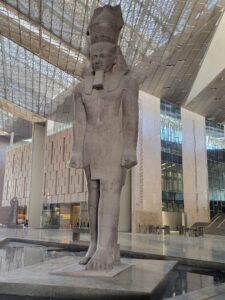
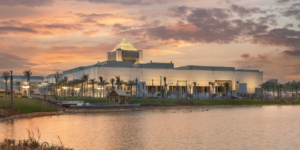
Just 30 minutes south of the Citadel lies another unique landmark, The National Museum of Egyptian Civilization (NMEC), that recently opened its doors to the public. The museum is divided into a chronological and a thematic area. It also houses the gallery of royal mummies, the final resting place of famous kings and queens of ancient Egypt. Imagine standing face-to-face with Ramses the Great as you admire the art of mummification and preservation. It is said that he is the Pharoah of Moses, making him the pharaoh of the Exodus.
Modern day Cairo
The city that never sleeps

There are various trendy restaurants and nightclubs that serve food from all over the world. From buzzing street food stalls to cosmopolitan fine dining. At 168 stories high, Cairo Tower is the tallest building in the city and offers the most amazing panoramic views from the roof’s revolving restaurant. Cairo at night is a totally different experience. You can enjoy live folkloric shows and belly dancing while sailing along the Nile on a 5-star cruise. Alternatively, you can take a romantic trip with a horse carriage ride. Or go on a walking night tour of downtown Cairo.
Alexandria
Alexandria is a port city on the Mediterranean coast of Egypt, founded in 331 BC by Alexander —the Great King of Macedon of the ancient Greek Kingdom. Alexandria grew rapidly to become an important centre and became the capital of Ptolemaic Egypt until the Muslims conquered it in 641 AD. Did you know that Cleopatra was born in Egypt, but of Greek royal descent? She was the first one to adopt the local customs and language. History depicts her as a woman who used her beauty and charm as a weapon, but she was actually educated in mathematics, astronomy, philosophy, and linguistics. According to ancient sources, Cleopatra had a love affair with the Roman general Mark Anthony and it is said that they were very fond of each other. Their romantic relationship had however a political element to it: She needed to protect her throne and maintain Egypt’s independence, while Anthony needed access to Egypt’s resources. Just like Cairo, Alexandria is a crossroad of civilizations, culture and religions.
Downtown Alexandria
A harmonious blend of Egyptian, Greek, and Roman influences
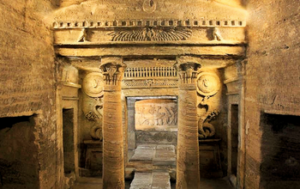
The Catacombs of Kom El Shoqafa, a Roman burial ground with three floors under the ground, are located in the old city of Alexandria and can be traced back to the second century AD. You will find Alexandrian tombs, statues, and archaeological objects having a combination of Egyptian, Roman, and Greek influences. Three sarcophagi have been found as well as human and animal remains at the necropolis.
Nearby you can find the Ancient Roman Amphitheatre dating back to the fourth century AD. It was discovered by accident in 1960 by construction workers. The theatre is part of the downtown area and located 30m under sea level. The archaeological site gives us a glimpse of Alexandria in Roman times and features baths, a villa with mosaic flooring, an impressive ancient white marble theatre, as well as a wide street surrounded by remnants of tall columns. The thirteen auditoria a bit further away were most probably part of the ancient university of Alexandria.
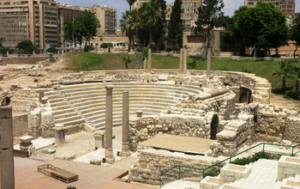
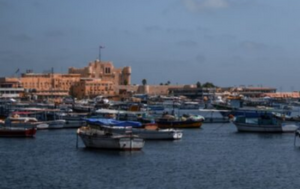
Alexandria was once home to a lighthouse built on the island of Pharos during the Ptolemaic Dynasty and considered one of the Seven Wonders of the Ancient World. It was considered the tallest building in the world during antiquity until it disappeared most likely due to an earthquake. The lighthouse stones were later used to construct the Citadel of Qaitbay, a medieval defensive fortress considered to be an important part of the fortification system of the city in the 15th century.
Saint Mark’s Cathedral is an important Coptic church in Alexandria. It is the seat of the Pope of Alexandria, who is the head of the Coptic Orthodox Church. The cathedral was founded in 60 AD by Saint Mark the Evangelist, author of the second gospel and one of the first Christians to preach in Egypt. In 68 AD he was arrested by the pagans of the city and dragged through the streets until death. After this tragedy, the Christians decided to bury him under the church. In 828, Venetian merchants stole relics believed to contain the body of St. Mark and took it to the St Mark’s Basilica in Venice. Copts believe that St Mark’s head is still in the Alexandrian cathedral, while the other parts are in Saint Mark’s Cathedral in Cairo and in Venice.
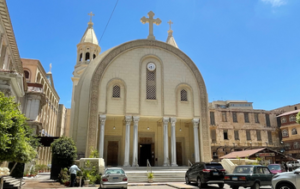
Bibliotheca Alexandrina
A major library and cultural center
As an important library and cultural center, Bibliotheca Alexandrina was built as both a memorial to the ancient Library of Alexandria and as a tribute to its glory. It seeks to revive the greatness that the Great Library of Alexandria had in the ancient world. Back in time, Alexandria was known as the capital of knowledge and learning, mainly thanks to the Great Library. The library suffered a big fire but was not entirely destroyed. It gradually deteriorated during the centuries until it was completely destroyed during an invasion between 270 and 275 AD.

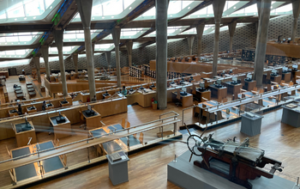
The current library has space for eight million books while the main reading room covers 20 000 square metres. A conference center, several specialized libraries, four museums, four art galleries for temporary exhibitions, 15 permanent exhibits, and a planetarium are also located within the complex. Aswan granite was used for the exterior walls and 120 human scripts were used to decorate them. Its book collection was donated from all over the world.
Museums and Palaces
Colonial architecture
Museums in Alexandria are worth visiting depending on how much time you have and what interests you. The National Museum of Alexandria is one such museum. It is located in a former Italian Renaissance-style mansion and houses more than 1800 artifacts, that tell the story of the city itself. A sculpture thought to be that of Alexander the Great was put on display in the museum not so long ago. Additionally, it also holds a collection of jewelry, weapons, statues, and glassware. Most of these pieces were donated by other Egyptian museums.

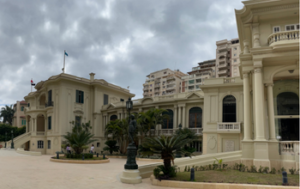
The Royal Jewelry Museum is an art and history museum that exhibits a rich collection of jewelry as well as artwork, paintings, and statues from the Mohamed Ali Dynasty, Egypt’s last ruling royal family (1805 and 1952). The building is a European-style palace built in 1919 and has beautiful lead-inlay glass windows and a big bathroom decorated with colorful ceramic tiles.
Montazah Palace —also known as King Farouk Palace— was once the penultimate and controversial Egyptian King’s summer palace. It contains elements of both Turkish and Italian architecture, with the central tower being inspired by Florence’s Palazzo Vecchio. Today it is only used for foreign diplomats and off-limits to visitors. You can still observe its magnificence from the lush surrounding garden and take in the breathtaking views of the Mediterranean Sea while enjoying the breeze.

Luxor
Luxor has nearly one-third of the world’s antiquities, making it the top city on the bucket list of those interested in history and civilization. Known as Waset by the ancient Egyptians and Thebes by the Greeks, Luxor was the capital of Upper Egypt between the 16th and 11th century BC during the New Kingdom. Homer referred to it as “Thebes of the Hundred Gates” in his Iliad, a city dedicated to the god Amun-Ra. Luxor is split into two banks: the East, representing life, and the West representing the after-life in ancient Egypt.
The East Bank
Karnak and Luxor Temple
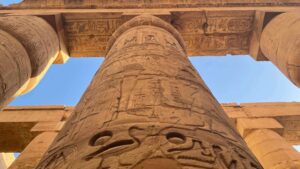
The Karnak Temple complex is a big open site. It is considered the largest complex in the world and the second most visited place in Egypt after the Pyramids of Giza. Approximately 30 different pharaohs contributed to the construction of the complex over the course of history, which spanned from the Middle Kingdom to the Ptolemaic age (2000 BC – 30 BC). The temple has a massive hall of 5000 m2 containing 134 massive ‘papyrus’ columns arranged in 16 rows and carved with many inscriptions and figures of pharaohs and deities.
A three km long Avenue of the Sphinxes connects Karnak temple to Luxor Temple. Located in the center of the city, the temple was mainly built by Amenhotep III and later enhanced by Tutankhamun, Alexander the Great, and Rameses II. The main entrance is adorned by colossal statues of Ramses II and baboons greeting the morning sun. Two obelisks once stood guard at the entrance, but today there is only one left, as the other one was gifted to the city of Paris. The temple has continuously been used as a place of worship. You will find remnants of a Christian church as well as a well-preserved Sufi mosque.
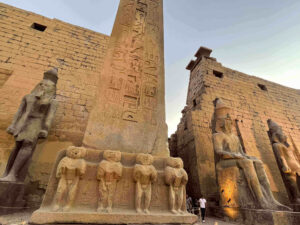
The west Bank
Valley of the Kings, the Queens and the Mortuary Temple of Queen Hatshepsut
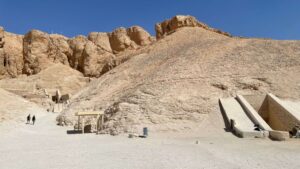
Crossing the Nile river from the east to the west bank is like a transfer from life to the afterlife. The monuments and tombs built by the ancient Egyptians along the west bank express their deeply rooted religious values and beliefs about the afterlife. And the Valley of the Kings forms no exception to that. A natural pyramid-shaped rocky mountain is home to 63 royal tombs dating 3600 years back, each richly decorated with sculptures, religious texts, and scenes portraying the pharaohs in presence of various deities. Nobles and other members of the royal family, as well as workers, were later also buried in the Valley of Kings.
Not so far away, lies the Valley of the Queens, a burial site for wives, mothers, sisters, and children of the kings. The valley contains over 75 tombs and was referred to as Ta-Set-Neferu, meaning “the place of beauty”. The tomb of queen Neferteri —wife of Ramses the Great— is a must-see for its perfectly preserved paintings and colorful walls.
Many royal tombs and temples can be found on the west bank of Luxor, but none are as impressive as the Mortuary Temple of Queen Hatshepsut, located near the Valley of the Kings. She is the second historically known female ruler of Egypt and is considered one of the most successful pharaohs. She claimed to be of divine birth, being an offspring of the god Amun-Re. She thus legitimized her ascension to the throne, saying her father wanted her to lead the country. Her temple is considered an architectural masterpiece, designed and built by her lover and architect Senenmut. The sanctuary is dedicated to the god Amun-Re and consists of three beautiful white terraces, beautiful chapels, and imposing statues.
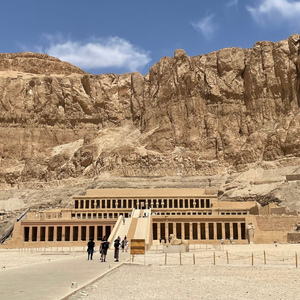
The Temple of Edfu
The Ptolemaic Temple of Horus
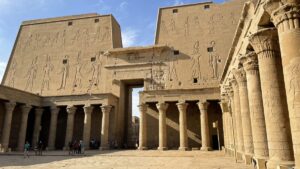
Cruising the Nile to the south you will first pass Edfu, a small town about 60km away from Aswan. This town houses the Temple of Edfu, which is considered one of the best-preserved temples in Egypt. It is dedicated to the cult of Horus, god of the sky, and Hathor, goddess of love and beauty. The wall carvings show scenes of the birth of Horus, Hathor visiting him, as well as other deities. At the end of the temple, stands a replica of the divine boat in which Horus’ statue would be paraded during religious celebrations; The Louvre (Paris) is now home to the original boat.
The Temple of Kom Ombo
The twin temple dedicated to Sobek and Horus
Another iconic landmark is the Ptolemaic Temple of Kom Ombo, which is the next stop after Edfu. Walking through the temple, you will notice many well-preserved engravings primarily dedicated to the gods Sobek —the crocodile god— and Horus, as well as scenes depicting other deities. This archeological site is remarkable as it’s home to twin temples that are constructed symmetrically. On the way out of the complex, you’ll find the small Crocodile Museum. It is a worthwhile visit for its unique collection of mummified crocodiles and several statues in the shape of crocodiles.
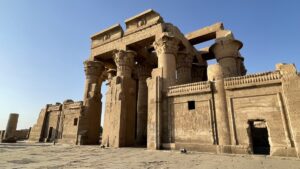
Aswan
To the ancient Egyptian known as Swenett (‘market or trade’), to the Nubians as Dib, (‘fortress or palace’), Aswan was and still is of great importance. It was the southernmost border of ancient Egypt while also being a bustling point of trade. Today, Aswan is still a key mining area and a major tourist destination. It is the land of the Nubians (meaning land of ‘Nob’ or “gold’), who are the original inhabitants of that area and who once ruled over a territory that stretched out till Khartoum in Sudan. Egypt’s most idyllic city has a distinctive African ambiance and laid-back atmosphere that sets it apart from the rest. It is where Arabia and Africa blend together in a unique way.
Philae Temple
The pearl of Egypt
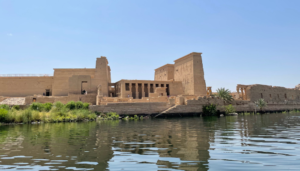
Philae was considered one of the burial places of the god Osiris by both the Egyptians and the Nubians and only priests could set foot on the tiny island. The Temple of Isis at Philae was built to honour the goddess Isis, as well as the god Osiris and Horus. The magnificent temple complex depicts various scenes of Isis reviving Osiris, giving birth to Horus, and mummifying Osiris. Until Islam, the temple has been a pilgrimage site for centuries, dedicated first to the cult of Isis during Greek and Roman times, then to Christian worship after a few of its chambers were converted.
The Nubian culture
A unique and rich cultural heritage
Aswan is home to the Nubians, who ruled an empire that stretched from the south of Egypt till Sudan and parts of Ethiopia. Known as Africa’s earliest kingdoms, Nubia was a rival state of ancient Egypt, until Lower Nubia was conquered by the Egyptians. While Egypt suffered many foreign invasions, the distant pharaonic Kingdom of Kush —what is now northern Sudan— prospered for over a thousand years. It is known that the queens of Nubia were strong women who either ruled themselves or shared the power with their husbands. The kandakes (a royal title for queens) even led armies into battle and it is said that warrior-queens stood strong against Greek and Roman invasions. While the Egyptians stopped using the pyramids as tombs, the Nubians continued burying their deads in smaller, steeper pyramids.
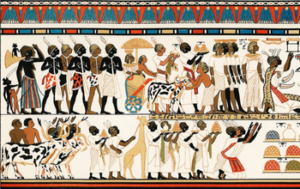
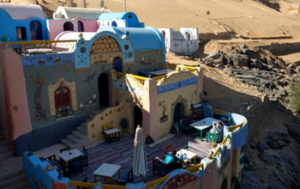
Today the Nubian culture continues to live on in modern-day Egypt. Nubians are very proud of their regional identity: they have distinctive attire, play traditional instruments, have their own music style, and speak their own language alongside Arabic. Aswan’s Nuba Museum offers a glimpse into their culture, but a visit to one of the Nubian villages will offer you a more valuable experience. Sail down the Nile in a felucca or a motorboat and watch colorful villages emerging into the distance. Explore the Nubian lifestyle and experience the incredible hospitality as you wander through the local villages.
The Unfinshed obelisk
More than 3500 years old
The Unfinished Obelisk is a 3500-year-old monolith that would have measured ca. 42 metres if finished. It is an open-air museum that offers a lot of insights into ancient construction techniques. The Egyptians typically carved obelisks into granite bedrocks and then transported them to their final location when completed. But why is it still lying there knowing that obelisks are typically placed at temple entrances? Due to its slightly longer height than traditional ones, it most likely developed a crack during construction and was therefore abandoned there.
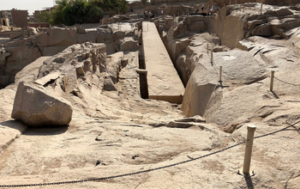
Abu Simbel Temple
Designed with great architectural precision
Located at the second cataract of the Nile, some 230 km southwest of Aswan, lie two impressive temples built in the 13th century BC by King Ramesses II into a solid rock cliff. It is considered one of the most majestic temples in Egypt and the most beautiful of temples built during the reign of Ramesses the Great. The construction took about 20 years to build, with the aim of daunting his enemies and elevating his rank among the gods.
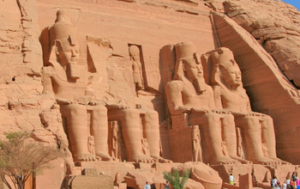
The entrance of the Great Temple is marked by four monumental statues of a seated pharaoh wearing the double crown of Upper and Lower Egypt. The interior of the temple is decorated with scenes of victorious battles, worship, and offerings to the gods as well as scenes of the pharaoh and his chief wife, Nefertari. The temple was built in such a way that twice a year the sun would pass through the entrance corridor and light up Ramesses’s face located in the inner sanctum. While the other two statues next to Ramesses would enjoy a few sunbeams too, the statue of Phat, the God of darkness, would remain completely in the dark.
This phenomenon is celebrated during the Abu Simbel Sun Festival, which takes place on October 22 and again on February 22. The temple was built in such a way that twice a year the sun would pass through the entrance corridor and light up Ramesses’s face located in the inner sanctum. While the other two statues next to Ramesses would enjoy a few sunbeams too, the statue of Phat, the God of darkness, would remain completely in the dark. This phenomenon is celebrated during the Abu Simbel Sun Festival, which takes place on October 22 and again on February 22.
The Small Temple is the temple of Hathor and Nefertari, and also has big statues at the entrance depicting the pharaoh and his queen, and is dedicated to the god Hathor and Nefertari. The walls of this temple are decorated with many religious scenes as well as scenes of the pharaoh and his wife fighting off their enemies.

Red Sea
The Red Sea is the northernmost tropical sea on earth and is home to an incredible variety of species and colorful corals. With its intense blue-green water, it is not only famous for its scuba diving and snorkeling spots, but it’s also a great place to de-stress and enjoy the beach, sun, and sea. Several archaeological sites can be reached by day trips from the Red Sea coast. Depending on where you are staying, you can either visit Luxor, Aswan, or even Cairo.
El Galala
A brand new town
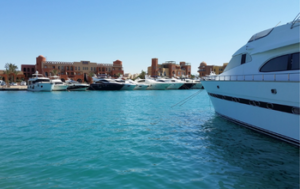
El Galala is a newly built seaside town on the northern shore of the Red Sea, about one hour and a half away from Cairo. New resorts, hotels, residences, and gulf courses are opening their doors as we speak. Thanks to its proximity to the capital, it will be an excellent location for business conferences and diplomatic meetings. The area is also spiritually significant as this is where Moses reportedly parted the waters and crossed the sea towards the Promised Land.
Built on different levels, the town offers its residents spectacular views of the Gulf of Suez. Its virgin beaches, slightly cooler temperatures, and relaxed atmosphere make it an ideal destination to escape the hustle and bustle of the nearby capital.
Hurgada
The most famous resort destination
Some of Egypt’s best resorts lie along the Hurgada coastline. It is a popular destination among tourists as well as Egyptians from across the country. The water here is typically clear, calm, and warm most of the year, making it ideal for scuba diving, snorkeling, and other water sport activities. There are a variety of day trips available from Hurgada: from desert jeep safaris to exploring the nearby islands to full-day tours to Luxor. Travellers will enjoy all that the city has to offer, whether they are singles, married or travelling with their family.

Marsa Alam
Pristine waters and untouched beaches

Marsa Alam is the southernmost resort town on the Red Sea Riviera of Egypt. It is home to largely untouched beaches, pristine waters, and amazing marine fauna and flora. It is an ideal location to celebrate a honeymoon or romantic getaway. Snorkeling, diving, and other water sports are available, and visitors can explore the colorful reef while swimming alongside sea turtles and dugongs. About 60 kilometers south of Marsa Alam lies Sharm El Luli, another treasure beach on the turquoise coast. It is blessed with powdery sands that blend seamlessly into the turquoise blue of the sea. Don’t forget to visit El Qulan Mangrove Forest. There is an amazing lagoon and big mangrove trees growing in the sea. Luxor and Aswan are excellent destinations, if you are looking for daytrips to historical landmarks.
Sinai
Located between the Gulf of Aqaba and Suez, the holy land of Sinai forms a peninsula overlooking the Mediterranean Sea and the Red Sea. Its red-sand mountains, coral reefs, and national parks make it a unique destination for all types of travellers. Sinai is considered as one of the most spiritual places of Egypt, where bedouins still continue to lead a traditional lifestyle.
Sharm el-Sheikh
A world-famous dive destination
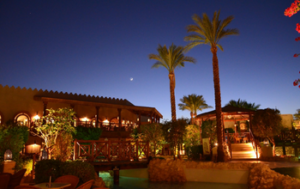
Sharm el-Sheikh is located in the south of the Sinai Peninsula and is well-known for its luxury resorts, restaurants, nightclubs and conference centres. The area is an incredible dive destination with various types of corals and fish. Besides being a popular destination among scuba divers, snorkelers, and sunbathers, Sharm el-Sheikh is also the gateway to explore St. Catherine’s Monastery and go stargazing in the Sinai Desert. If you are looking for a more low-key holiday, head over to Dahab. One of Dahab’s best secrets is the crystal clear blue lagoon. While a paradise for kite- and windsurfing, it’s also a great place to relax and take in the scenery.
Saint Catherine's Monastery and Mount Sinai
One of the oldest working monasteries
At 2285 meters, Mount Sinai is a popular religious pilgrimage site, where the prophet Moses is said to have received the Ten Commandments. From Saint Catherine’s monastery, you can hike up the mountain and watch the sunset rise above the horizon. It is one of the oldest Christian monasteries still operating today. The monastery has many unique works of art, books, manuscripts, and other treasures, such as the Codex Sinaiticus, the oldest handwritten Greek bible in the world. Visitors who wish to experience the calming beauty of the mountains nearby have the option to stay in the monastery’s guesthouse.
